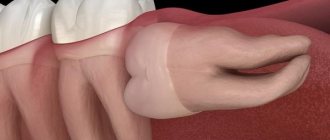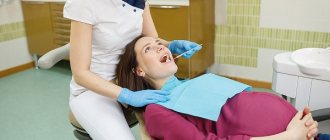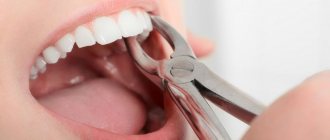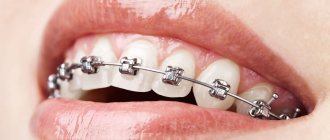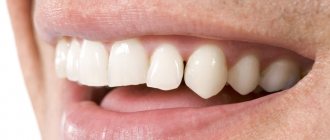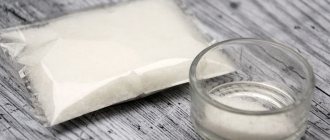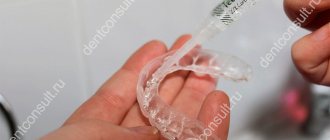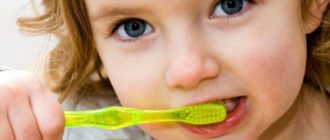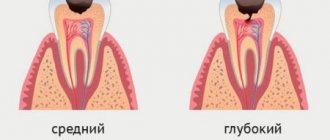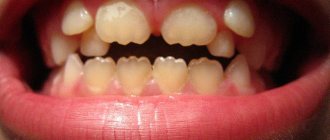Causes
One of the main causes of abnormal bite is genetic predisposition. The hereditary factor is activated against the background of concomitant causes - chronic diseases or bad habits.
Various internal and external factors contribute to protruding front teeth.
You can get rid of the problem in several ways - from performing myogymnastics to installing orthodontic devices.
The choice of treatment depends on the patient’s age and the severity of the defect.
All newborns have a distal position of the lower jaw. The norm is considered to be a deviation from the level of the upper dentition by 1-10 mm. In the absence of problems in the child’s development and breastfeeding, the bite gradually returns to an orthognathic state. In addition to hereditary factors, there are a number of factors that can cause protruding teeth.
One condition that may require surgery may be gothic palate.
This type of oral cavity structure is characterized by an excessively high position of the upper wall of the oral cavity. The cause can be both congenital and acquired pathologies in childhood.
Dentist
Novikova Olga Alexandrovna
8 years of experience
General somatic diseases of the patient
According to statistics, abnormal bite is observed in 60% of people who suffered from rickets in childhood. Also, inflammatory processes on the mucous membranes of the mouth, short frenulum, and injuries lead to a pathological condition. The anomaly can even develop as a result of improper positioning of the child during rest.
Chronic nasopharyngeal disease
About 35% of people who have problems with nasal breathing are faced with the problem of an abnormal bite. Such pathologies include:
- inflammation of adenoid tissue;
- deviated nasal septum;
- constant runny nose.
The upper teeth protrude in children who often suffer from ARVI. With a runny nose, the child is forced to constantly breathe through the mouth, which leads to the development of a high palate. In this condition, the upper jaw becomes deformed and protrudes forward.
Bad habits (especially in children)
For example, biting nails, sucking fingers or foreign objects. This causes changes in facial proportions, including distal occlusion.
Children often have several habits at once, leading to the formation of occlusion or the development of one of them into another, for example, incorrect posture. Curvature of the spinal column entails many problems, including orthodontic ones.
Early change of baby teeth
If baby teeth are severely damaged by caries, the dentist may decide to remove several elements of the row. The nearby bone structures begin to shift to free areas. As a result, there is no longer any space left for the molars, and they begin to grow upward.
How do “eights” erupt?
Wisdom teeth are the last teeth to erupt. Sometimes at 18–20 years old, but more often at a later age. In addition to the fact that these are the largest teeth, there are cases when they are located in the jaw bone not vertically, but at an angle. Therefore, problems most often arise with their eruption: the tooth does not grow upward, but to the side, pressing on the root of the nearest tooth, causing pain and inflammation. Often, to avoid such problems, wisdom teeth are removed without waiting for them to fully erupt.
Wisdom teeth often cause problems when they erupt
But if the tooth grows more or less without problems, the person does not see a dentist; there is no indication for tooth extraction. And then it turns out that due to the growth of molar No. 3, the front teeth have moved.
“Eights” are large teeth, and if there is not enough space in the dentition, they move neighboring teeth, and even the front ones.
Crowded teeth
Is it possible to remove a tooth and return everything as it was?
If you remove a tooth, nothing will change. Orthodontist patients know that after treatment a consolidation stage is needed, otherwise the roots of the teeth will begin to move to their old familiar place. It takes at least two years for the teeth to adjust and strengthen in their new position, and to do this they are held in place with the help of retainers and aligners.
During orthodontic treatment, the pressure from braces or aligners is much greater than that exerted by the growing wisdom tooth. Therefore, with an orthodontic system, teeth are moved within a few months, and the first results are visible within a few weeks.
Aligners correct the position of teeth in a few months
A growing molar erupts very slowly, over 2–3 years, and puts pressure on neighboring teeth, causing them to move. The process occurs almost imperceptibly, the teeth shift by fractions of a millimeter per month. During this time, they get used to the new (wrong) position. The ligamentous apparatus that supports the teeth is rebuilt to a new position, and the bone tissue around the roots is strengthened. And even if wisdom teeth are removed, it will not be orthodontically beneficial. Neither from a health point of view, nor from an aesthetic point of view.
Classification
With pathology, the upper teeth protrude forward, completely or partially covering the lower row. In this position, the jaws can no longer close together normally. In rare cases, an abnormal location is observed not in the front, but in the lateral teeth of the upper jaw.
There are 2 types of pathology:
- Neutral bite. This anomaly cannot always be determined by external examination of the oral cavity. Even in an adult whose bone tissue is fully formed, the pathology may not manifest characteristic signs. In the case of a neutral occlusion, the chin does not change its natural structure, and serious facial disproportions are not noticeable. The main signs of the pathological condition are the overlap of the lower jaw with the teeth of the upper row, the presence of a noticeable supramental fold.
- Distal bite. In such a situation, the symptoms of pathology are clearly expressed. In adults, there is disproportion of the face, with the chin being unnaturally small and slightly moved back.
The diagnosis of malocclusion is made definitively after examination by a dentist.
Correction
What do they do in dentistry if a tooth has moved? First of all, a diagnosis is carried out to understand the reason why this happened. An X-ray examination will help to get a clear and clear picture.
A treatment plan is then developed, which may include the following methods:
- Disocclusion
The jaws are opened using a removable therapeutic prosthesis, a fixed bridge, or special mouth guards. The goal is to apply intermittent pressure to the involved teeth to move them back into place.
- Sanding hard fabrics
Used only in adult patients over 40 years of age if the disocclusion method did not work. After the problem has been eliminated, prosthetics are performed.
- Orthopedic
Occlusion is restored using inlays, artificial crowns, and pin structures.
- Orthodontic
Correct displacement of the center of teeth or other anomalies with the help of plates, braces and aligners.
- Surgical
In case of high mobility, severe occlusion, or chronic inflammatory processes, teeth are removed.
Symptoms
Symptoms of the problem are classified into two categories - facial and oral. The main features of the first group are as follows:
- strongly pushed forward;
- crooked chin;
- shortened lower third of the skull;
- protruding upper lip;
- sharply defined supramental fold;
- parted mouth.
Among the functional signs are noted:
- the appearance sagittal fissure;
- abnormal position of the lateral teeth;
- difficulty chewing food;
- pain in the temporal region;
- impaired speech functions.
Other symptoms of pathology occur depending on the cause of the abnormal bite. One of the listed symptoms is a reason to contact an orthodontist. In a child, pathology is easier to eliminate than in adults, since in childhood the location of the teeth is not yet completely fixed.
Why can our articles be trusted?
We make health information clear, accessible and relevant.
- All articles are checked by practicing doctors.
- We take scientific literature and the latest research as a basis.
- We publish detailed articles that answer all questions.
Without medical attention, a distal bite can cause complications such as teeth grinding or bruxism. The latter type of disease often manifests itself after treatment of the problem, if the therapy was carried out too late.
Asymmetry in the face, smile, bite
If you notice any signs of asymmetry in a child, this is a reason to immediately consult a doctor. At any age of the child - as soon as noticed. Of course, all people are naturally asymmetrical. But natural asymmetry is not visible to the eye and does not attract attention. What you need to pay attention to in terms of asymmetry: • displacement of the chin to the side • the smile is not symmetrical • the central lines of the upper and lower jaws do not coincide (with each other and with the central line of the face). The orthodontist will be able to conduct an examination and prescribe the necessary treatment or examination to identify the causes of asymmetry.
Diagnostics
Diagnosis of pathology includes not only identifying an abnormal bite, but also determining the cause of its occurrence. To accurately assess the condition of the jaw system, a set of measures is carried out:
- Teperentgenography. Thanks to the procedure, the doctor identifies existing defects in the jaw bones and also assesses the condition of the alveolar processes.
- Tomography. It is prescribed to determine the localization of the head of the mandibular joint.
- Casts. Models are used to study the structural features of bone tissue elements.
- Electromyography. Prescribed when analyzing the chewing functions of the jaw.
- Study of the dentition using the Schwartz method. The technique allows you to identify a type of abnormal bite.
- test . Another way to determine the type of pathology.
How to correct an overbite
To correct malocclusion at an early age, more gentle methods are used. An effective method of combating abnormal bite is gymnastics for the facial muscles. Such exercises in medicine are called myogymnastics. The results of the procedure can only be achieved with regular exercise.
Bite trainers
In order to correct bites in children and even simple dental defects in adults, it is not at all necessary to install complex, inconvenient and expensive devices.
The following types of gymnastic techniques are common:
- Bringing the lower jaw forward. Remain in this position for several minutes, and then relax the facial muscles. Gymnastics are performed until a feeling of fatigue appears in the jaw muscles.
- Raising the tongue. During the exercise, the tongue extends and rises to the area of the upper palate.
Correction of abnormal bite in children
Maximum results can be achieved by combining myogymnastics and orthodontic devices. To correct the bite on baby teeth, devices with screws are used that regulate the width of the structure and the development of bone structures.
In some cases, trainers or LD activators are prescribed to correct the defect. The main purpose of using structures is to give the lower jaw a natural position and relax the facial muscles.
Orthodontic appliances are effective for both primary and molar teeth. Removable dentures can be used before installing braces, while the use of trainers reduces the time of wearing the regulatory system. It is important to remember that you can achieve results from wearing removable correctors only with their regular use.
In children from 8 years of age, Twin Block systems can be used to correct the bite. The device consists of two plates that act on bone tissue mechanically. In this case, the lower jaw moves forward. Before installing the system, I take an impression of the teeth and determine the type of anomaly.
In some cases, patients are offered the installation of partial braces on already renewed teeth. The design allows you to align abnormally located elements and give them the correct angle.
In advanced cases of problems or when the above methods do not produce results, the Herbst device is used. It consists of two spring elements, one of which is attached to the upper jaw (sixes), and the other to the lower row of teeth (premolars). The mechanism gradually aligns the position of the jaw system, pushing the lower row of teeth forward and the upper row back.
Methods for eliminating the defect
Direct veneers or crowns can be used to correct protruding teeth. But this method is more of an aesthetic nature. It does not solve the problem at the root, but only masks it. Veneers are suitable if one or maximum two teeth are protruding.
To correct the bite, it is recommended to use braces. The disadvantage of this treatment is the long period. But the advantages are invaluable, because as a result it is possible to correct the location of each individual tooth.
In some cases, several teeth may have to be removed. This is done when there is a lot of crowding and there is no space for straightening the teeth.
If the central teeth protrude after wearing braces, a different treatment system is used.
During the so-called retention period it is recommended to use:
- removable retainers;
- fixed retainers.
Which type to choose depends on the complexity of the curvature. If it is minor, removable mouthguards are used. They are plastic overlays that perfectly fit the shape of your teeth. Mouthguards are made individually, based on an impression. If it is necessary to strengthen the structure, wire is installed in the retainers. The orthodontist develops a plan for wearing mouth guards.
Fixed retainers are metal arches. They are attached to problem areas and cannot be removed. Fixation occurs on the inside of the teeth, so the patient does not feel discomfort when wearing them. The duration of use of the arches, as well as their shape, is selected individually.
Unfortunately, the problem of protruding teeth cannot always be solved with veneers or braces. If long-term correction does not give the desired result, the doctor may recommend using the Herbst apparatus. The non-removable design corrects even very complex defects in just 1 year. Changes are visible immediately after its fixation. The Herbst appliance gradually moves the upper jaw backward and the lower jaw forward.
